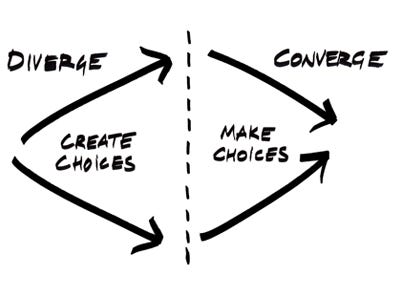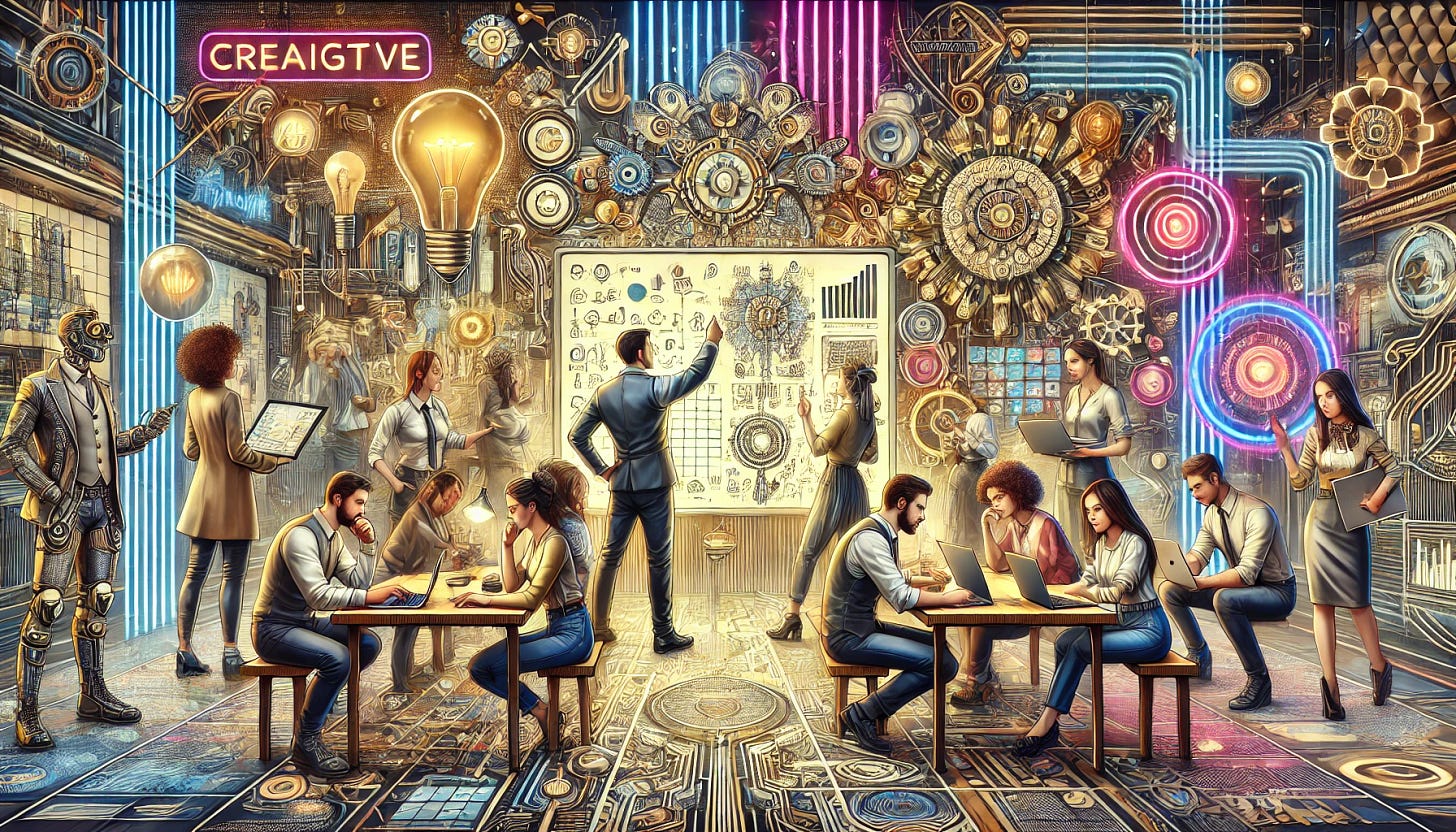Escaping the discussion trap
Discover how to escape the endless cycle of unproductive meetings and foster effective decision-making in your teams and organisation
What is the discussion trap?
The discussion trap is a common problem where teams and leaders get caught in a cycle of endless talking without making any real decisions. Imagine being on a merry-go-round that never stops. You're moving, but you're not actually getting anywhere.
Contrary to popular executive opinion, people don’t fall into this trap because people are collaborating too much; it's because the way they come together, talk and decide isn’t well-structured or guided effectively.
In the discussion trap, meetings seem to drag on forever, covering the same ground over and over. It's like treading water in a pool—you’re active, but you’re not moving forward. Ideas are thrown around, debated, and dissected, but they rarely turn into concrete actions. This leads to wasted time, lower productivity, and missed opportunities.
The whole organisation can feel like it's stuck in quicksand, unable to move ahead because it's bogged down by endless discussion.
Also, this trap isn’t simply about having too many discussions. It’s about having discussions that lack purpose and direction.
Without a clear framework or goals, conversations can turn into unproductive debates. People might think they’re contributing, but without focus, their efforts don’t lead to progress.
The discussion trap can also damage trust and morale. Imagine being in a car that’s stuck in traffic for hours. You feel frustrated, like your time is being wasted. Team members can feel the same way—frustrated that their input isn’t leading to real change.
Over time, this can lead to a culture of indecision, where the fear of making a wrong choice stops people from making any choice at all.
Understanding the discussion trap means recognising that the problem isn’t with discussion itself, but with how the discussion - and the broader context of the discussion - is managed. Effective collaboration isn’t about how much you talk, but how you make sure conversations and series of conversations are focused, time-bound, and lead to actions.
How do you get stuck in the discussion trap in the first place?
Leaders and teams often find themselves ensnared in the discussion trap due to a combination of structural and cultural factors. Here are some of the key reasons this happens:
1. Lack of clear goals and outcomes
Meetings without a defined purpose tend to drift aimlessly. When leaders do not set clear intentions, discussions lack focus and direction. You might think having an agenda solves this problem. Whilst it can help to have more structure, it is possible to go through a structured agenda without making any meaningful decisions to move things forward.
Without an overarching intention for the meeting, workshop or process, participants end up feeling uncertain about what they are trying to achieve, resulting in conversations that circle back on themselves without producing actionable outcomes. Clear goals provide a roadmap, guiding discussions towards a productive end.
2. Poorly designed and facilitated processes
I get asked all the time to facilitate a meeting or workshop and then often am presented with a structure or agenda. The people asking me usually do this thinking they are being helpful, but I very rarely accept facilitating something that I haven’t been involved in the design of myself. As a professional facilitator, my facilitation doesn’t start in the room - it starts from designing what happens in the room and finishes when what happens in the room culminates in a clear decision that moves things forward (which may happen after the discussion event).
Ineffective processes can bog down discussions. Sloppy facilitation can bog down discussions. Without a well designed approach, and strong facilitation, teams may find themselves getting lost in details or side-tracked by irrelevant issues. Implementing a clear, step-by-step process for discussions and decision-making can help keep conversations focused and productive. Engaging a professional facilitator that can manage the energy and attention of the group helps ensure that the discussion is purposeful and actually leads towards a decision.
3. Endless meetings without time limits
Meetings that lack defined time constraints can become excessively long and unproductive. When there is no set duration to get to certain decisions, participants may feel free to digress into tangential topics, causing the core issues to be neglected. Setting a time for a meeting seems pretty obvious, especially at work where you tend to schedule meetings in a calendar anyway.
But timeboxing specific agenda items, and ensuring that each agenda item has a specific decision-making intention, helps maintain focus and encourages efficiency, ensuring that discussions remain on track and within the allocated timeframe. If you don’t get to a decision within the timeframe, that’s ok. It tells you that you might need to schedule more time or facilitate more tightly to get to a decision.
4. Absence of accountability
Without clear accountability, it’s easy for discussions to go around in circles. When no one is explicitly responsible for making a decision, the process can become muddled. Assigning a decision-maker or a responsible party - upfront if possible - ensures that there is a person or group who will take ownership of the outcomes. This clarity reduces ambiguity and drives the decision-making process forward.
5. Perfectionism and fear of making mistakes
Teams often fall into the trap of over-analysing options in the pursuit of the perfect solution. This perfectionism can lead to analysis paralysis, where the fear of making a wrong choice prevents any decision from being made. Encouraging a culture that accepts mistakes as part of the learning process can help teams move past this fear and make more timely decisions.
6. Inadequate preparation
When participants come to meetings unprepared, discussions can become inefficient. Lack of preparation can lead to rehashing information that should have been reviewed beforehand or failing to address key points due to missing information.
Ensuring that all participants have the necessary background information and have done their homework can make discussions more efficient and effective.
7. Groupthink and lack of diverse perspectives
Groupthink occurs when the desire for harmony and conformity in a group leads to irrational decision-making outcomes. It can stifle creativity and critical thinking, resulting in sub-optimal decisions. This can happen even when you do have diverse perspectives in the room that are not encouraged and facilitated to bring those diverse perspectives to the discussions efficiently. This could happen due to a lack of psychological safety, power imbalances, and basic neurodiversity.
Encouraging diverse perspectives and fostering an environment where different viewpoints are valued can counteract groupthink and lead to more robust discussions and better decisions. Something that helps with this tremendously is a facilitation principle known as ‘alone together’, where participants are given time to think about and write down their personal thoughts on something before sharing and synthesising the collective thoughts towards making a particular decision.
By understanding these underlying issues, you can better identify if you’re slipping into a discussion trap (or are already there!) and how you might prevent falling into it again.
However, being caught in the discussion trap can be so painful that, even at the risk of being repetitive, I think it’s worth sharing more specifically some things you can do to escape it.
Think of the below as your starter cheat-sheet to identify and escape the discussion trap.
How can you escape the discussion trap?
1. Recognise if you are creating choices or making choices
One of the key starting points in avoiding the discussion trap is understanding whether you are in a phase of creating choices or making choices. The initial phase of decision-making will and should feel more discussion-heavy, allowing for divergent thinking and generating a variety of ideas and options. At some point though, every purposeful discussion needs to start converging to “make choices” (or decisions), narrowing down the ideas and options made in the previous phase.
This general concept of creating choices and making choices scales right down to a single meeting, and scales up to an entire design and development process. You’ll recognise this in various co-design approaches, sometimes with the divergence and convergence being cyclical across a series of stages, like in service design for example.
Recognising this shift and clearly defining when it’s time to move from exploring possibilities to deciding on actions helps in maintaining clarity, direction and forward momentum. It’ll also help you decide how loosely or tightly to moderate discussion.
2. Engage a professional facilitator
Bringing in a professional facilitator can make a significant difference. A facilitator not only manages the flow of discussions but also ensures that conversations remain focused and productive. They are skilled in guiding the group towards a decision, handling the dynamics within the room(s), and maintaining momentum.
Observing a professional facilitator can also provide valuable insights into effective facilitation techniques, which can be adopted by the team for future meetings. As an organisational coach, I’m often mindful that I’m not just facilitating a process but representing what good facilitation looks like that others might want to learn from and adopt more independently. So, I also take up opportunities to experience other facilitators and see what I can learn from them.
Remember, it’s never too late to engage a good facilitator in an overarching process. A good subject-matter expert or consultant without a good facilitator might make your discussions richer, but won’t necessarily keep or get you out of the discussion trap. A good facilitator, on the other hand, will likely get more out of the group you already have.
3. Set clear goals for each discussion
As I mentioned in the previous section, every meeting should start with a clear purpose and ideally some specific objectives. Making a meeting agenda up of ‘topics’ is dangerous, because a topic doesn’t necessarily have a clear end-point and could be discussed indefinitely. If you find yourself in a meeting and realise half way that you’re not clear about the intention of that meeting or a particular point of discussion you’re on - just call it out. The sooner you ask to clarify the goal of whatever you’re talking about the faster you’ll escape the discussion trap, and everyone will thank you for it, even if silently.
Defining what you want to achieve ensures that the discussion stays on track. Clear goals act as a roadmap, guiding the conversation towards actionable outcomes. This helps prevent the aimless wandering that often characterises unstructured meetings.
4. Timebox discussions
Implementing strict time limits for each agenda item can greatly enhance efficiency. By allocating specific durations to topics, you encourage participants to stay focused and make timely decisions. Timeboxing also helps in identifying when a topic requires further discussion, allowing for better planning and more efficient use of meeting time.
A technique I use to help me allocate timeboxes to items in a meeting or workshop is to think in percentages rather than duration first. I’ll write up a program, add in the things I know will have fixed durations (e.g. breaks, keynotes) and then decide what weighting different items may require based on importance and complexity. Then I’ll calculate how much time that affords them in the total time available.
5. Assign accountability for getting to decisions upfront
Ensure that there is a clear decision-maker or tie-breaker identified at the beginning of the discussion. This person or group will take ownership of making a decision if there isn’t a clear one emerging, reducing ambiguity and ensuring that decisions are made. Clear accountability drives the decision-making process forward and prevents discussions from becoming circular.
If a discussion does get circular, as a facilitator don’t be shy to jump in and call that out, and request the designated decision maker or tie-breaker to make the final decision. The final decision may be that the group need to schedule another time to continue the discussion further.
6. Cultivate an action-bias
This is a big one.
To escape the discussion trap, it’s crucial to get your team away from a discussion-bias towards an action-bias.
While thoughtful discussions are valuable, they should always serve the purpose of informing and driving action.
Encourage team members to focus on actionable steps and concrete outcomes rather than endless deliberation. Develop a culture that values swift decision-making and execution. This will significantly reduce the time spent in meetings and increase overall productivity.
But how do you do this without creating haste and rashness? A few things:
(a) Integrate principles of experimentation, prototyping, and design thinking.
(b) Encourage your team to adopt a mindset of continuous experimentation. Quickly turn ideas into prototypes and test them in real-world scenarios. This iterative process allows for rapid learning and adaptation. It reduces the fear of failure and promotes a culture of innovation.
Prototyping also transforms abstract discussions into tangible outputs. It provides clear evidence of directional correctness and areas for improvement.
(c) Adopt agile delivery practices that specifically shorten feedback loops and encourage iterative development, accelerating decision-making and ensuring that solutions are continuously refined based on actual user feedback rather than internal discussion.
(d) Promote transparency, accountability, and alignment with regular reviews and retrospectives. Keep the focus on action and results. Set your team up with pre-scheduled opportunities to pull yourselves out of the discussion-trap.
What happens when you escape and avoid the discussion trap?
Escaping the discussion trap requires a combination of clear goals, effective facilitation, time management, accountability, and a bias towards action. By implementing these strategies, you can transform endless discussions into productive meetings that drive real progress and innovation.
The benefits of escaping and avoiding the discussion trap are significant. You'll notice increased productivity as your meetings become more focused and efficient. With clear goals and structured discussions, the time you spend in meetings will lead to actionable outcomes, reducing wasted time and enhancing your overall workflow. Effective facilitation and time management keep conversations on track, allowing for quicker decision-making and implementation of ideas.
Furthermore, by fostering accountability and an action-bias, you create a culture of decisiveness and execution. This shift not only boosts morale by showing that everyone's contributions lead to real change but also builds trust within your team. As your team members see tangible results from their efforts, engagement and satisfaction will naturally increase. A culture that values swift decision-making and continuous improvement also encourages innovation, as your team feels empowered to experiment and iterate without the fear of getting stuck in endless debates.
Ultimately, by avoiding the discussion trap, you'll go a long way towards leading a more dynamic and agile organisation, capable of responding to challenges and opportunities with speed and efficiency. This transformation not only benefits your internal operations but also enhances your ability to deliver value to stakeholders and achieve strategic objectives.
It may seem like a very specific and maybe even small thing, but by escaping the discussion trap, and staying out of it, you can truly unlock your team's full potential and drive sustained success.
If you enjoyed this, you might also appreciate:
The most helpful foundation for high performing collaboration (with examples)
If you make a bet with a friend, it's a good idea to define what winning the bet looks like in advance. That way you avoid conflict, confusion and chaos throughout and at the point of settling the bet. Sounds pretty intuitive, right? But somehow when it comes to work, I've seen countless leaders and teams struggle to define what winning looks like.







